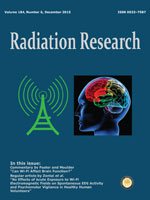A unique feature of the space radiation environment is the presence of high-energy charged particles, which can be significantly hazardous to space flight crews who are exposed during a mission. Health risks associated with high-LET radiation exposure include cognitive injury. The pathogenesis of this injury is unknown but may involve modifications to dendritic structure and/or alterations in dendritic spine density and morphology. In this study, 24 two-month-old C57BL6/J male mice were either whole-body irradiated with 0.5 Gy 56Fe (600 MeV/n; n = 12) or sham irradiated (n = 12). Three months postirradiation animals were tested for locomotor activity and habituation. After behavioral testing, animals were euthanized and the brains were flash frozen. Compared to sham-irradiated mice, irradiated mice moved less when first introduced to the environment, although they did recognize the environment when re-exposed to it one day later. Exposure to 56Fe radiation significantly compromised the dendritic architecture and reduced spine density throughout the hippocampal tri-synaptic network. To our knowledge, these data represents the first reported evidence that high-LET radiation has deleterious effects on mature neurons associated with hippocampal learning and memory.
How to translate text using browser tools
18 November 2015
56Fe Irradiation Alters Spine Density and Dendritic Complexity in the Mouse Hippocampus
Antiño R. Allen,
Jacob Raber,
Ayanabha Chakraborti,
Sourabh Sharma,
John R. Fike
ACCESS THE FULL ARTICLE

Radiation Research
Vol. 184 • No. 6
December 2015
Vol. 184 • No. 6
December 2015




